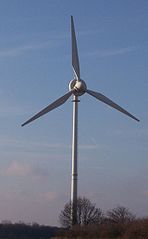Life-Cycle Analysis and Wind Power

Although there are additional considerations in the form of land use and ecological impact to birds and bats that complicate matters, wind remains attractive overall from an LCA perspective. Concerns about land use, it seems to me, need to take into consideration that turbines can be deployed in pasture land, orchards, etc. And while it’s true that birds are occasionally killed, they’re many thousands of times more likely to die at the hands of cats, automobiles, and plate-glass windows.
From a cost perspective, mid-sized approaches on the order of a few hundred kilowatts that may be appropriate for corporate campuses, factories, schools, and so forth pay themselves off in a period of three to eight years, depending on incentives, the prevailing rates for electricity from the local utility, and wind characteristics. My friends at Continental Wind offer a good solution in this space, for anyone who may be interested.

Birds are also more likely to die due to health effects from pollution caused by burning fossil fuels. And many bird species will go extinct due to climate change. Both points are missed by those who complain about wind turbines and birds.
Absolutely right.
Also from a full life cycle perspective, wind power produces about 1-2% the amount of GHGs per kWh of power delivered that US average grid electricity produces! Happy to help with any LCA calculations, just get in touch 🙂
LCA of fossil fuel (or nuclear) powered electricity production presumably shows a good return in terms of direct power out v power consumed. Until, that is, you start to quantify the externalities – pollution, climate impact, resource depletion, security, legacy management, etc – which is no mean feat and open to dispute on every point. It would be very interesting to see a calculation that attempts this challenge.